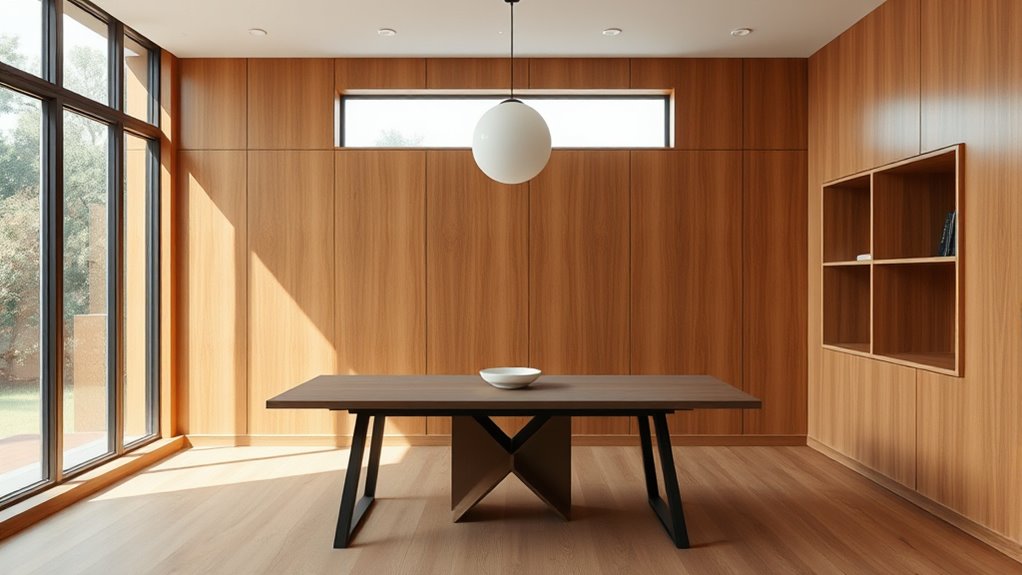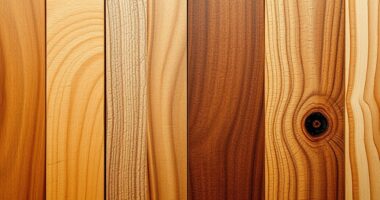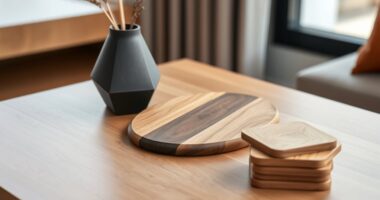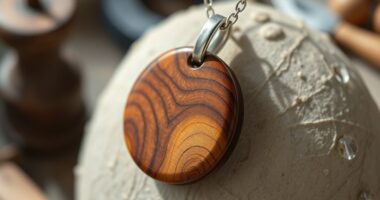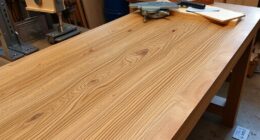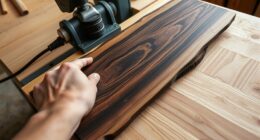Wood in modern interior design adds warmth, texture, and natural charm to your space. It seamlessly blends with various styles like minimalist, rustic, or biophilic themes, creating an inviting atmosphere. From wall panels and furniture to detailed accents, wood enhances aesthetics while supporting sustainability through responsible sourcing. Its versatility and timeless appeal can transform any room into a cozy, stylish haven. Keep exploring to discover how you can elevate your interiors with the beauty of wood.
Key Takeaways
- Wood adds warmth, texture, and natural beauty to modern interiors, creating inviting and cozy spaces.
- Incorporating wood supports sustainability through eco-friendly sourcing and enhances biophilic design principles.
- Popular wooden elements include slat walls, reclaimed panels, and sculpted furniture, adding visual interest and character.
- Wood seamlessly blends with various styles like minimalist, rustic, and biophilic for versatile modern aesthetics.
- Proper finish choices and strategic placement highlight wood’s natural features, elevating overall interior design.
The Appeal of Wood in Contemporary Interiors
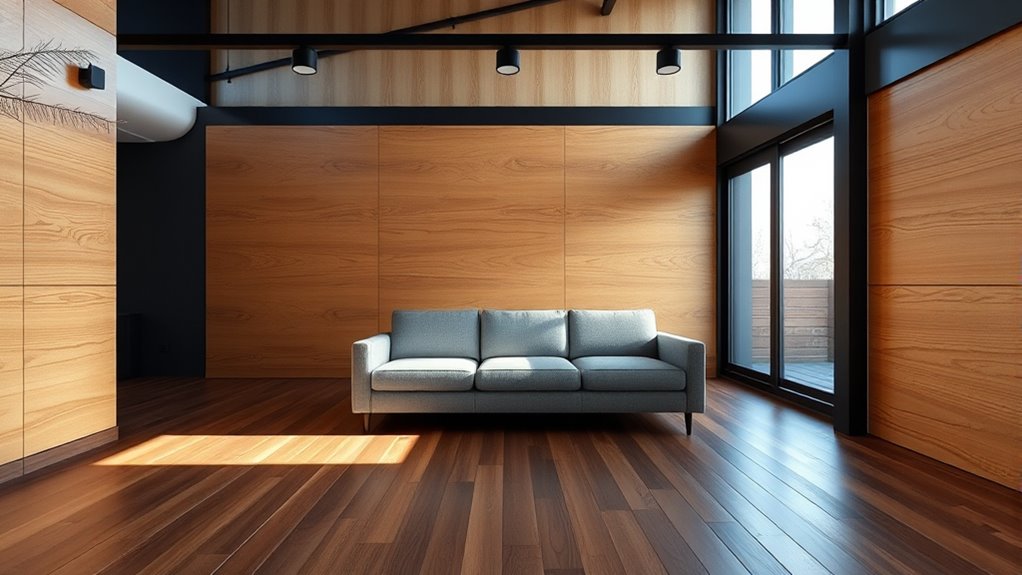
Have you ever noticed how wood instantly adds a warm, inviting feel to modern interiors? Its natural textures bring a cozy ambiance that elevates any design. Wood’s versatility allows it to blend seamlessly with contemporary styles like minimalism, biophilic themes, and bold color accents. In modern interior projects, wooden wall panels, flooring, and furniture create depth and visual interest without overwhelming the space. Using sustainably sourced wood also supports eco-friendly trends, appealing to environmentally conscious choices. Additionally, incorporating natural materials like wood enhances the authenticity and rustic charm of interior designs. Plus, data shows that 82% of office workers exposed to wooden surfaces report higher satisfaction, highlighting wood’s positive impact on well-being. Incorporating energy-efficient heating solutions, such as modern heat pumps, can further enhance interior comfort while supporting sustainability. Overall, wood’s organic warmth and natural beauty make it a key element for creating inviting, stylish interiors.
Key Benefits of Using Wood in Home Design
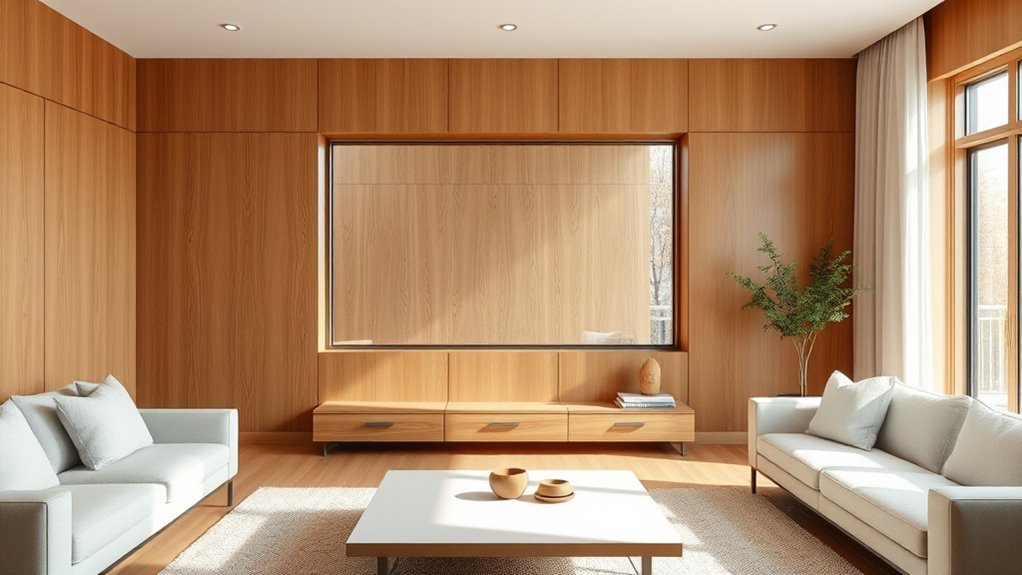
Using wood in your home adds natural warmth and texture, making your space feel inviting and timeless. It’s also a sustainable, durable material that requires minimal maintenance, so your design stays beautiful for years. Plus, its versatility lets you create everything from rustic to modern looks effortlessly.
Natural Warmth and Texture
Wood’s natural warmth and organic textures instantly create inviting and cozy atmospheres in home interiors. You’ll notice how the tactile quality of wood enhances sensory engagement, making your space feel more comfortable and welcoming. Incorporating wood adds depth and visual interest through its varied grain, color, and finish, enriching your interior design. Its natural warmth fosters emotional well-being by connecting you to nature and reducing stress. When you use wood, you benefit from a versatile material that brings character and charm to any room. Additionally, the inherent aesthetic appeal of wood contributes to a timeless and elegant look that complements various decorating styles. Embracing natural techniques for wood treatment can further enhance its durability and aesthetic, ensuring your interior remains beautiful over time. Using sustainably sourced wood also supports eco-friendly practices, making your design choices more environmentally responsible.
Sustainable and Durable Material
One of the key advantages of wood in home design is its sustainability, especially when you source it responsibly. As a natural material, wood is renewable and eco-friendly, making it a smart choice for sustainable living. Its durability allows wooden furniture and structures to last for decades with minimal maintenance, reducing waste and replacement costs. Thermally modified wood further enhances resistance to moisture, pests, and decay, extending its lifespan even in challenging environments. Choosing locally sourced or salvaged wood minimizes transportation emissions and supports eco-conscious practices. Additionally, wood’s insulating properties boost energy efficiency, lowering heating and cooling costs. Properly treated wood, such as vetted options, can significantly enhance the longevity and performance of your home features. Incorporating sustainable forest management practices ensures that the wood you select continues to be an environmentally responsible choice. Innovative wood treatment techniques, such as pressure treatment, can further improve its resistance and lifespan. By selecting sustainable, durable wood, you create a home that’s not only beautiful but also environmentally responsible and built to last.
Popular Wooden Elements in Modern Spaces
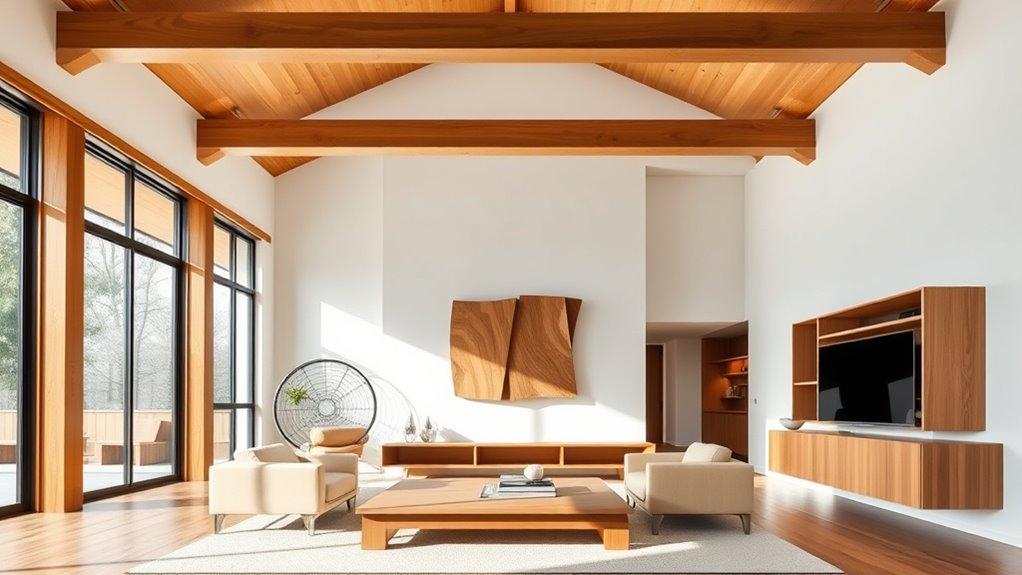
In modern interiors, wooden elements are essential for adding warmth, texture, and visual interest. You’ll see wooden slat walls and ceilings creating dynamic textures that enhance the space’s depth. Reclaimed wood panels add sustainability and craftsmanship, making your environment feel cozy and eco-friendly. Sculpted wood furniture, like reeded chairs and tables, serves as striking focal points that seamlessly blend style and function. Large wooden beams and wood paneling define architectural features, giving your space character and structure. To elevate the aesthetic further, consider incorporating:
- Wooden slat walls and ceilings
- Reclaimed wood panels for feature walls
- Sculpted or reeded wood furniture pieces
Understanding wooden elements can help you select the right materials to achieve a cohesive and inviting modern design. These elements combine form and function, making your space both beautiful and inviting, while also integrating natural materials that promote a calming atmosphere. Additionally, selecting sustainable wood sources can enhance your commitment to eco-friendly design practices. Exploring wood treatment techniques can also enhance durability and visual appeal, ensuring your wooden features stand the test of time.
Integrating Biophilic Principles With Wooden Materials
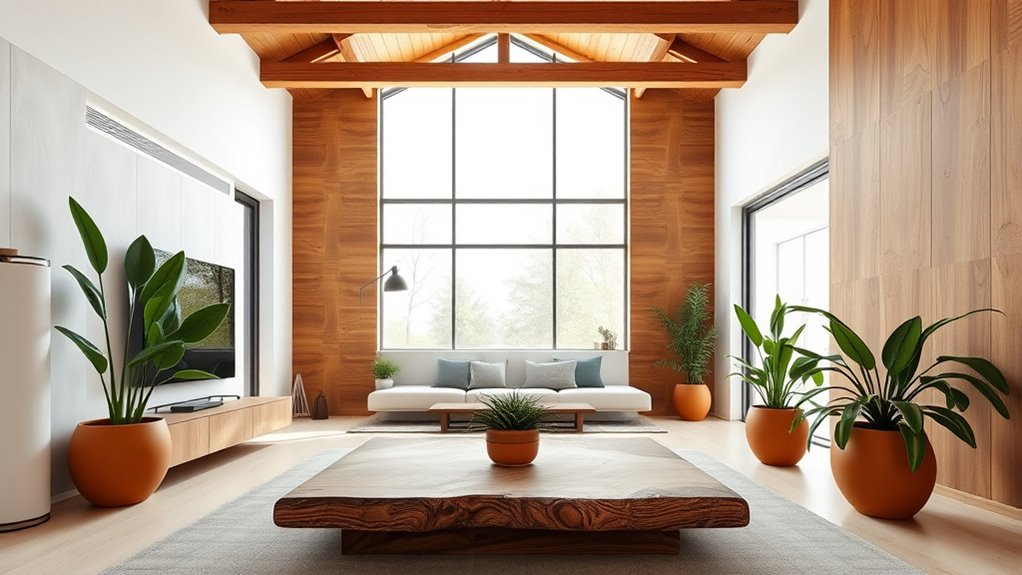
You can strengthen your space’s connection to nature by using wooden materials that mimic natural textures and patterns. Choosing responsibly sourced wood supports sustainability while enhancing the calming environment. Combining wood with plants and natural light amplifies these biophilic benefits, creating a healthier, more inspiring space. Incorporating natural textures into your design can further enhance the sense of tranquility and harmony. Utilizing sustainable materials ensures that your design remains environmentally conscious while promoting well-being. Additionally, selecting wood with visible grain patterns or knots can add a more authentic and natural appearance, enriching the overall aesthetic. Embracing biophilic design principles can deepen this connection and foster a sense of well-being within your space. Incorporating AI-driven security systems can also improve safety, ensuring a secure environment that complements the natural aesthetic.
Nature Connection Enhancement
Have you ever noticed how the warmth and texture of wood can instantly make a space feel more connected to nature? By integrating wooden features, you strengthen the natural connection within your indoor environment, aligning with biophilic design principles. Using large wooden elements like slat walls, beams, or natural finishes creates a seamless visual and tactile link to the outdoors. This not only enhances comfort but also boosts well-being—82% of people report higher satisfaction with wooden surfaces around them. Additionally, sourcing wood sustainably supports eco-friendly practices, reducing ecological footprints. To maximize nature connection:
- Incorporate wooden textures and finishes
- Use large wooden features for visual impact
- Combine wood with indoor plants for a richer natural feel
- Consider wood in modern interior design options that balance aesthetics and sustainability
- Emphasizing automation in business can help optimize resource management and reduce waste, further supporting sustainable design choices.
Research indicates that asset division laws can vary significantly by region, influencing how you approach your design or legal considerations.
Sustainable Material Benefits
Integrating wooden materials into interior design not only enhances the natural feel of a space but also offers significant sustainability benefits aligned with biophilic principles. Sustainably sourced wood has a lower carbon footprint during processing, making it an eco-friendly choice for environmentally conscious projects. When you select wood from responsible harvesting practices, such as FSC or PEFC certified sources, you support forest conservation and ecological balance. Wood’s natural textures and organic warmth foster a stronger connection to nature, improving mental health and well-being. Additionally, its excellent insulation and noise absorption properties create healthier, more comfortable indoor environments. By choosing sustainable wooden materials, you promote environmental sustainability while enriching interiors with natural, biophilic qualities that benefit occupants and the planet alike. Implementing sustainable practices in sourcing and processing further ensures that the environmental benefits of wooden materials are maximized.
Trendy Styles and Inspirations for Wooden Interiors
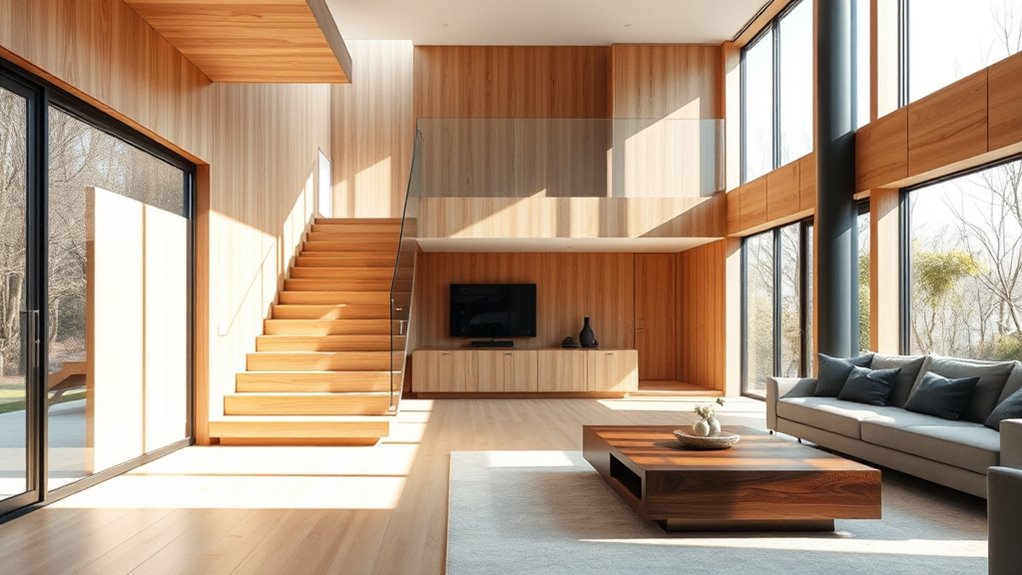
Trendy wooden interior styles draw inspiration from diverse aesthetics, blending traditional craftsmanship with modern sensibilities. You’ll find that *wooden interiors* now reflect a variety of *design styles*, each emphasizing unique characteristics of *natural materials*. For a clean, minimalist look, Scandinavian interiors use light-colored finishes and simple *furniture pieces* to create bright, calming spaces. Rustic styles highlight raw, distressed wood and exposed beams, evoking warmth and coziness. Wabi Sabi interiors celebrate imperfection, showcasing aged wood alongside stone and linen for a serene, understated vibe. Meanwhile, Mid-Century Modern design features sculpted, reeded wood with organic shapes, merging functionality with artistic flair. These styles showcase how versatile *wood in modern design* can elevate your interior aesthetic.
Practical Tips for Incorporating Wood Effectively

To incorporate wood effectively into your interior, start by selecting the right type and finish that align with your desired aesthetic—matte finishes work well for rustic styles, while glossy options complement modern designs. Use wood as a focal point with feature walls or statement furniture to add visual interest without cluttering the space. Incorporate wooden accents sparingly in accessories and small furnishings to subtly enhance warmth and texture. Consider durable, sustainable options like thermal-modified wood or engineered veneer for practicality and cost efficiency. Be mindful of balance by pairing wood elements with other materials and colors, ensuring your interior design feels harmonious rather than overwhelming. Thoughtful placement and finish choices help you create a cohesive look that highlights the natural beauty of wood.
Notable Projects Highlighting Wooden Design Excellence

Numerous projects demonstrate how wood can elevate interior design from functional to extraordinary. These spaces showcase the versatility of wood in creating a warm, inviting atmosphere. For example:
Wood transforms interiors from simple to stunning with warmth and natural charm.
- The Big Sur retreat features square-edge clear vertical grain old-growth redwood cladding, highlighting the natural beauty and durability of high-quality wood in interior walls.
- Parisian apartments use limed stained oak panels, emphasizing sophisticated wood in interior design for modern urban living.
- Aurora James’ LA home incorporates rich wood walls that add depth and warmth, transforming residential spaces with wooden surfaces.
These projects prove that wood, whether as wooden furniture or wall treatments, enhances the ambiance. Creating a warm, natural environment, they demonstrate how wood in interior design elevates everyday living into extraordinary spaces.
Frequently Asked Questions
How Is Wood Used in Interior Design?
You use wood in interior design to create warm, inviting spaces. It’s versatile, so you can incorporate it in flooring, furniture, wall paneling, and accents. You choose different types like oak or reclaimed wood based on grain and color, then finish it with matte or glossy coats to match your style. Whether rustic beams or sleek cabinets, wood adds texture and character, making your space feel cozy and stylish.
What Wood Is Used in Modern Homes?
In modern homes, you’ll find a variety of woods like oak, maple, and walnut used for flooring and furniture because they’re durable and have beautiful grains. Thermally modified woods and reclaimed options add eco-friendly appeal and unique character. Light-colored woods like ash and birch brighten spaces, while engineered woods such as plywood and veneer offer versatile, affordable solutions for cabinetry and wall coverings.
What Wood Looks Modern?
When you ask what wood looks modern, you’re seeking options that fit sleek, contemporary spaces. You’ll find that light-colored finishes with smooth surfaces, minimal grain, and clean lines create a modern vibe. Engineered woods, like veneered panels, offer uniform textures that suit minimalist styles. Pairing these with bold monochromatic tones or high-gloss finishes, along with geometric or laser-cut patterns, enhances their modern appeal.
What Interior Design Style Uses a Lot of Wood?
Imagine walking into a room where the warmth of wood greets you like an old friend. Scandinavian design uses a lot of wood to create airy, minimalistic spaces that feel both cozy and sophisticated. It’s like a canvas that highlights natural light and simplicity. If you love clean lines and a calm atmosphere, this style’s the perfect way to showcase wood’s versatility and timeless appeal in your interior.
Conclusion
Embracing wood in your modern interior creates warmth and timeless appeal, transforming your space into a sanctuary of natural beauty. By thoughtfully selecting and integrating wooden elements, you enhance both style and function. Remember, a picture is worth a thousand words, and a well-designed wooden interior speaks volumes about your taste. So, don’t wait to bring nature indoors—sometimes, the best way to find yourself is to lose yourself in the natural elegance of wood.
